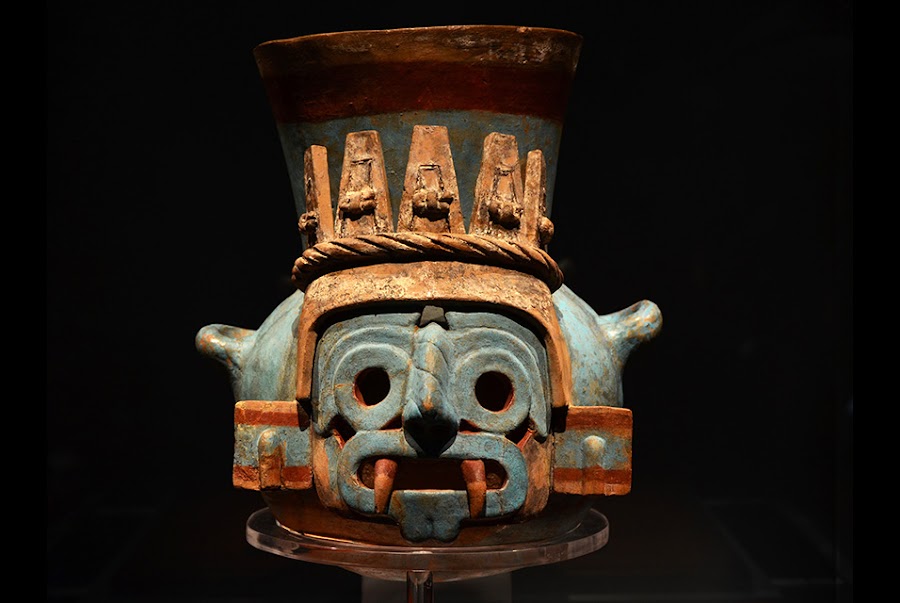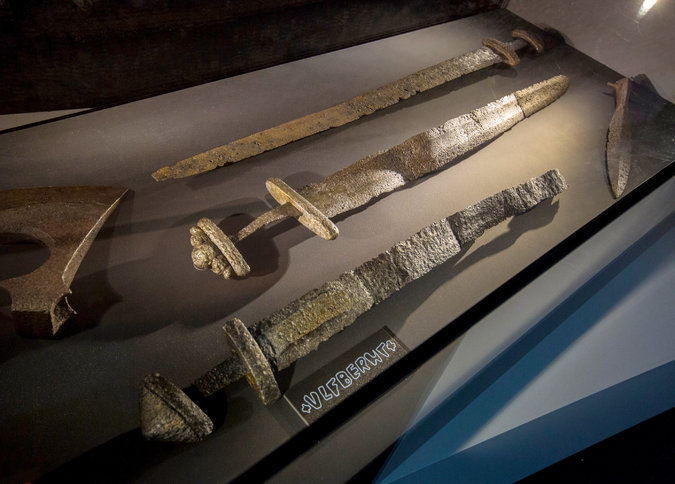Pointe-à-Callière presents a major exclusive international exhibition, The Aztecs, People of the Sun. Visitors will have the unique privilege of learning about the people who founded the fabulous city of Tenochtitlan, capital of the Aztec Empire and the site where Mexico City was built after the Spanish Conquest in 1521. The exhibition, presented from May 30 to October 25, offers insights into the dazzling world of a people who reigned over much of Mexico for two centuries.

The exhibition, produced by Pointe-à-Callière in collaboration with the Mexican National Council for Culture and the Arts – National Institute of Anthropology and History (INAH), showcases some 265 items from 16 Mexican museums, including the Templo Mayor Museum, an archaeological site museum like Pointe-à-Callière itself, and the Mexican National Museum of Anthropology. The tremendously varied objects are both spectacular and moving. Masks and statues, gold jewellery, figurines of women, children and animals, stamps for creating patterns on fabric and skin, sculptures and objects relating to the sacrifices required to keep the Sun on its daily journey, chests, boxes for offerings, vases and ceramics, all reflect the mysteries surrounding this people.
Stunning artifacts
The highlights of the Montréal exhibits include some of the most remarkable remains from the Aztec civilization. Two statues from the Templo Mayor Museum, each weighting 250 kg and standing 170 cm (nearly 6 feet) tall, are sure to appeal to visitors’ imaginations. The terra cotta statue of an eagle warrior, with jagged claws protruding from his knees front and back and his face emerging from an eagle’s beak, could also represent the rising Sun. This true work of art was found in the House of the Eagles, next to the Templo Mayor, used for rituals and penitential ceremonies. The terra cotta statue of Mictlantecuhtli shows the god of death leaning forward toward humans. With his skull-like face, pierced with holes for hair to be inserted, his shredded skin and clawed hands, stained with human blood, he is a terrifying sight!
Other items with splendid colours, like the vessel representing Tlaloc, the rain god, tell us more about the Aztecs’ lifestyle and deities. This vase is considered one of the masterpieces of Aztec art, and shows the god with his typical “goggles” and fangs, in his usual blue colour. The pyramid shapes on his headdress are references to the mountains where the Aztecs believed Tlaloc stored the water that would later fall as rain.
A wooden mask inlaid with turquoise, shell and mother-of-pearl is one of the rare Aztec “turquoise masks” to have survived. It may be a reference to the god Quetzalcoatl, whose face is emerging from the mouth of a serpent. This rare piece comes from the “Luigi Pigorini” National Museum of Prehistory and Ethnography, in Rome.
A ceramic piece with three faces, adorned with 13 circular gems, or chalchihuitl, evoking the 13 months of the sacred calendar, is also stunning. It decorated a brazier or a funerary urn, and shows the three phases of existence: in the centre, youth opening its eyes to the world, followed by an image of old age, and then the face of inescapable death, with its eyes closed, all referring to passing time. This sublime piece expresses the cyclical principle of duality, so important in Aztec thought, where life is reborn from death.
There are also images drawn from historic codices, photos of archaeological sites and remains, and different videos. Then there are some 150 unique hand-built and painted figurines made in Mexico to create a colourful, joyous scene depicting the vast Tlatelolco market held north of Tenochtitlan in days gone by.
Exhibition themes
The exhibition focuses on the founding of Tenochtitlan, capital of the Aztec Empire, their daily lives, the Templo Mayor, and of course the question of human sacrifices and the two Aztec calendars. It looks at many themes in their rich history: the Aztecs’ migration, guided by their god Huitzilopochtli, and the founding of Tenochtitlan; the remarkable urban planning and land use development in this “Venice of Mexico”; the Aztec art of war and the tribute paid by conquered peoples, as well as their agricultural techniques and the chinampas, the ingenious floating gardens that made the city self-sufficient. It also looks at the organization of Aztec society, with its different classes, a fascinating subject that addresses the role of women, education and the administration of justice. Aztec writing and the famous codices, manuscripts made up of glyphs or pictograms illustrating the spoken language, are examined in depth. Religion, an essential and omnipresent part of Aztec society, along with their various deities and rituals, are described. And lastly, the exhibition closes with a description of the Spanish conquest and the fall of the Aztec Empire, and the legacy of the Aztecs today.
Who were the Aztecs?
The story of the Aztecs began around the year 1000, when a warrior tribe, probably driven by famine, set out on a long southward migration. Despite many difficulties on their odyssey, they persevered, trusting in the god watching over them to reveal the place where they could finally found their city. And so it was that in 1325 the Aztecs, or Mexicas, founded the city of Tenochtitlan, building a temple on an island in marshy Lake Texcoco, in the central Mexican highlands. The capital was divided into four districts, watched over by the gods associated with the four cardinal directions. In a sacred precinct in the centre of the city stood the main temples, including the Templo Mayor or “Great Temple,” which would become the heart of their city and the centre of their spiritual and material universe. The Aztec Empire lasted almost 200 years, until 1521. They built lavish palaces, temples and markets there, creating an immense metropolis with a population of about 200,000 at its height. Theirs was an imperialistic society that relied on diplomacy and near-constant warfare to expand their empire and collect tribute in the form of regular “taxes” from the peoples they conquered.
A highly innovative civilization
Tenochtitlan was founded on a shallow, marshy lake. The Aztecs were able to increase the habitable area of their city by planting pilings and installing platforms to hold sediment from the lake. Thanks to this ingenious system, the city was crisscrossed by canals, and chinampas, or true floating gardens, were created where they could grow various crops. These remarkably fertile gardens produced up to seven harvests a year, feeding much of the city. The system was also used to recycle the city’s organic waste. The Aztecs developed trade in cocoa, maize and other crops, which were sold in markets of all sizes, and produced striking ceramics and magnificent gold and silver finery.
A life governed by gods and calendars
Like many other Mesoamerican peoples, the Aztecs divided their universe into three main levels: the sky, the Earth – an island with the Templo Mayor at its centre – and the underworld, inhabited by the god of the dead and his companion. The god and goddess of duality were the source of four creative principles occupying the “four roads of the universe” corresponding to the four cardinal directions. For the Aztecs it was important to constantly maintain the balance among the divine forces – a delicate exercise governed from day to day by following two calendars that dictated not only the maize planting and harvesting cycle but also the rituals required to appease some 200 different gods.
The Aztecs considered time to be cyclical, and human lives to be influenced in turn by their gods, at regular intervals, as spelled out in the two interlocking calendars. The solar or annual calendar lasted 365 days and consisted of 18 months of 20 days, adding up to 360 days. The remaining five days were seen as highly inauspicious – it was best to avoid all activity on those days! In every month a major god was honoured. Since this calendar governed agricultural activity, it included many feasts dedicated to the rain god Tlaloc and to plant deities.
The sacred calendar also dictated religious ceremonies and important dates. Each day was defined by a glyph or written sign (there were 20) and a number from 1 to 13. These signs and numbers combined in an unchanging order, and the same combination of signs and numbers repeated until the 13 x 20 possibilities were done, that is for 260 days. Every 52 years, the solar and sacred calendars aligned once again. For the Aztecs, this was a time of fear and anguish, since they didn’t know whether it signalled the end of the world.
The importance of the Sun and human sacrifice
The Aztecs worshipped the Sun, and feared that it would disappear if they didn’t perform various rituals. Just like many other pre-Columbian civilizations, they also engaged in human sacrifice. These sacrifices were considered offerings and an essential part of the various rituals associated with their religion and daily life. Victims were put to death to nourish the Sun and the Earth. When the rains failed to appear and crops were at risk, for instance, the Aztecs would sacrifice children to regain the favour of the rain god. Different kinds of victims were sacrificed: warriors captured in battle, slaves, people condemned to death for offences, and children.
Highly significant codices
The Aztecs had a special form of writing. They transcribed their language, Nahuatl, using a combination of glyphs, figures and graphic elements. These manuscripts, known as codices, are an inexhaustible source of details about their economy, and include tax rolls, property registers, politics, history, education, religion, sacred rituals and science. They are key to our understanding of Aztec civilization.
The Aztec heritage
When he first saw Tenochtitlan and its many canals, Hernán Cortés of Spain compared it with Venice. But despite his admiration for the city, he had no scruples about laying it to waste in 1521. Cortés left Cuba with about 500 men, on a mission to secure the interior of Mexico. After being greeted with splendid gifts by Moctezuma II, Cortés soon took the Aztec Emperor prisoner. The destruction of Tenochtitlan marked the end of the Aztec Empire and launched the colonization of all of Latin America.
Today the Aztec civilization is considered one of the most remarkable in human history. Many archaeological digs and different museums celebrate their exceptional contribution to world heritage. Mexico City, the country’s capital and largest metropolis, was built atop the ruins of the superb city of Tenochtitlan. Today it is home to some 22 million people. The Aztec language, Nahuatl, is still spoken by about 1.6 million Nahuas. Today’s Mexicans also carry the memory of the Aztecs in their name. When their god Huitzilopochtli guided the Aztecs to the site where they would found Tenochtitlan, he called his people Mexicas. Even today, a divine eagle perched on a cactus devouring a serpent – the sign that the god had sent to the high priest of the Aztecs to tell them where to found their city – adorns the Mexican flag and banknotes. And one can still travel by boat along the canals built by the Aztecs, in Xochimilco and other districts of Mexico City.
Source: Pointe-à-Callière [May 29, 2015]
































